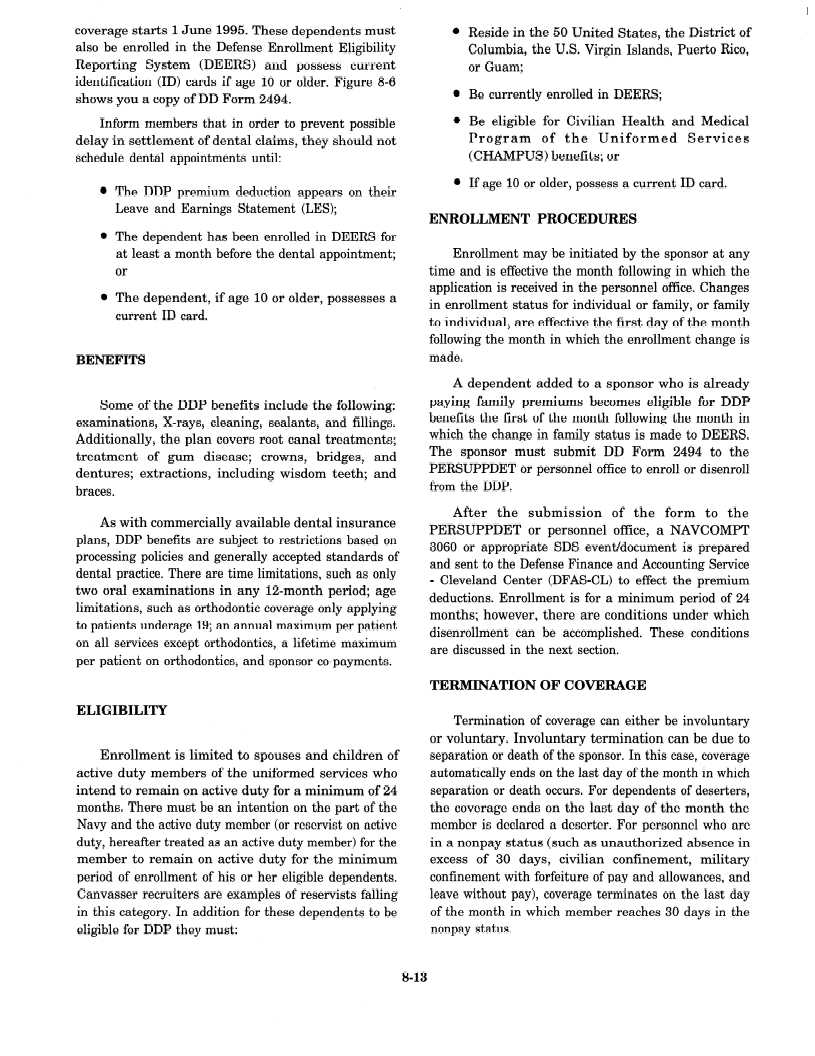| |
coverage starts 1 June 1995. These dependents
must
also be enrolled
in the Defense Enrollment
Eligibility
Reporting
System
(DEERS)
and
possess current
identification
(ID) cards if age 10 or older. Figure 8-6
shows you a copy of DD Form 2494.
Inform
members that in order to prevent possible
delay in settlement
of dental
claims, they should not
schedule dental appointments
until:
The DDP premium
deduction
appears on their
Leave and Earnings
Statement (LES);
The dependent has been enrolled in DEERS for
at least a month before the dental appointment;
or
The dependent,
current ID card.
BENEFITS
if age 10 or older, possesses a
Some of the DDP benefits
include
the following:
examinations,
X-rays, cleaning,
sealants, and fillings.
Additionally,
the plan covers root canal treatments;
treatment
of gum
disease;
crowns,
bridges,
and
dentures;
extractions,
including
wisdom
teeth;
and
braces.
As with
commercially
available
dental insurance
plans, DDP benefits are subject to restrictions
based on
processing policies and generally
accepted standards of
dental practice. There are time limitations,
such as only
two oral examinations
in any 12-month
period;
age
limitations,
such as orthodontic
coverage only applying
to patients underage 19; an annual maximum per patient
on all services except orthodontics,
a lifetime maximum
per patient
on orthodontics,
and sponsor co-payments.
ELIGIBILITY
Enrollment
is limited
to spouses and children
of
active duty members of the uniformed
services who
intend
to remain
on active duty for a minimum
of 24
months. There must be an intention
on the part of the
Navy and the active duty member (or reservist on active
duty, hereafter treated as an active duty member) for the
member
to remain
on active duty for the minimum
period of enrollment
of his or her eligible dependents.
Canvasser recruiters
are examples of reservists falling
in this category. In addition
for these dependents to be
eligible for DDP they must:
l
Reside in the 50 United
States, the District
of
Columbia,
the U.S. Virgin
Islands, Puerto Rico,
or Guam;
l
Be currently
enrolled in DEERS;
l
Be eligible
for Civilian
Health
and Medical
Program
of
the
Uniformed
Services
(CHAMPUS)
benefits;
or
l
If age 10 or older, possess a current ID card.
ENROLLMENT
PROCEDURES
Enrollment
may be initiated
by the sponsor at any
time and is effective the month following
in which the
application
is received in the personnel office. Changes
in enrollment
status for individual
or family, or family
to individual,
are effective
the first day of the month
following
the month in which the enrollment
change is
made.
A dependent
added to a sponsor who is already
paying
family
premiums
becomes eligible
for DDP
benefits the first of the month following
the month in
which the change in family
status is made to DEERS.
The
sponsor
must
submit
DD Form
2494 to the
PERSUPPDET
or personnel office to enroll or disenroll
from the DDP.
After
the
submission
of the
form
to
the
PERSUPPDET
or personnel
office,
a NAVCOMPT
3.060 or appropriate
SDS event/document
is prepared
and sent to the Defense Finance and Accounting Service
- Cleveland
Center (DFAS-CL)
to effect the premium
deductions. Enrollment
is for a minimum
period of 24
months;
however,
there are conditions
under which
disenrollment
can be accomplished.
These conditions
are discussed in the next section,
TERMINATION
OF COVERAGE
Termination
of coverage can either be involuntary
or voluntary.
Involuntary
termination
can be due to
separation or death of the sponsor. In this case, coverage
automatically
ends on the last day of the month in which
separation or death occurs. For dependents of deserters,
the coverage ends on the last day of the month
the
member is declared a deserter. For personnel who are
in a nonpay status (such as unauthorized
absence in
excess of 30 days,
civilian
confinement,
military
confinement with forfeiture
of pay and allowances, and
leave without
pay), coverage terminates
on the last day
of the month in which member reaches 30 days in the
nonpay status.
8-13
|

